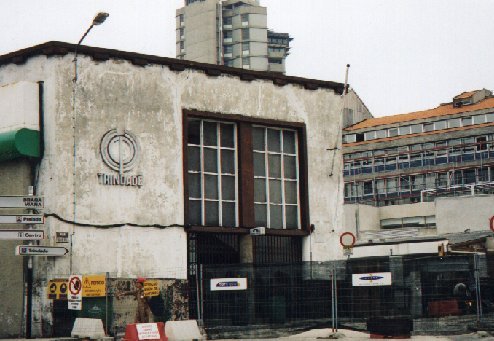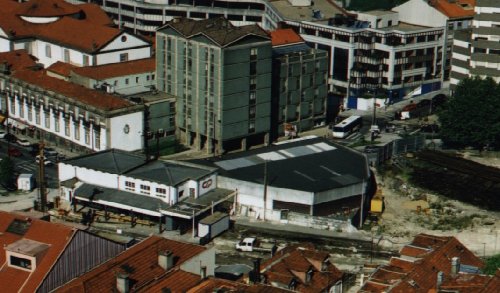Oporto Metro Metro do Porto
NB The Metro do Porto's own website has further information on the system.
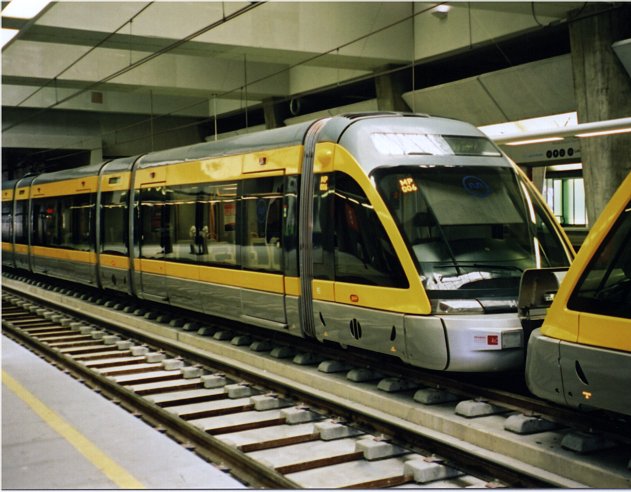
Above: Metro do Porto coupled units in operation during summer 2005.
The Metro has transformed Oporto's local transport since December 2002 when commercial services started. It replaced a local narrow gauge system based on Trindade station in central Oporto as well as some of the routes formerly operated by the STCP trolleybus system. In addition, new lines have been created and many more stations added to pre-existing routes.
There are currently six Metro lines (2011), which are described, briefly, below. The system currently comprises 80 stations (14 underground) and the line length is 67km (2011). In 2010, 54 million ticket validations were recorded on the network and in the first 6 months of 2011, 29 million passengers used the network. Line E in particular grew in that half-year - usage being up by 29%. The new Linha Laranja (F), opened on 2 January 2011 towards Gondomar accounted for 627,000 users.
The System
The Oporto Metro system is operated by ViaPorto (an previously by Transdev) under the brand of Metro do Porto S.A., a body in which the local regional council and STCP (Sociedade de Transportes Colectivos do Porto), which operates the city's bus system, both have an interest. The Metro's shares were originally 70% owned by the local metropolitan authorities, with STCP (Sociedade de Transportes Colectivos do Porto) holding 25%. STCP operates the city's bus fleet. The remaining 5% of Metro do Porto is owned by the national railway operator, CP (Combóios de Portugal). However, from 1 April 2010 the operating contract was awarded to ViaPORTO, a group led by Portuguese transport company Barraqueiro, which also operates the Fertagus railway line in Lisbon and the MST metro in Almada (see links above).
In 2005, the Oporto Metro system carried nearly 18.5 million passengers, nearly double its 2004 level. By October 2006, 3,789,680 ticket validations were recorded and average daily trips numbered 122,248. The busiest line is line D and the busiest stations in 2006 were Trindade, with 28% of traffic followed by Casa da Música (8.5%), João de Deus (6.3%), Senhora da Hora (6.1%) and Bolhão (5.9%).
Lines
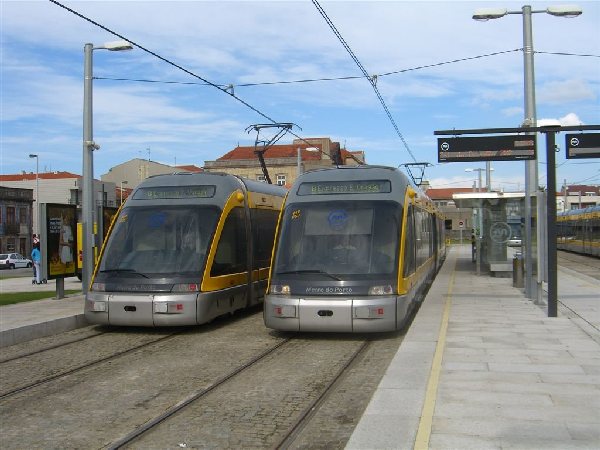
By 2011 there were six Metro lines, all of which run roughly north to south, though one of them, the Yellow Line D, bisects the other four at the two-level Trindade station in the city centre. By 2008 the network was 59km in length of which 7km was in tunnel. The tunnels include a 4km stretch under the centre on Line D, whilst a 2.35km tunnel links Trindade in the city to Campanhã main-line station in the outskirts. At the other end of the scale, Line D soars high above the River Douro on the magnificent Ponte D. Luís of 1886 (see below).
Right: Two trams at Póvoa, 2 October 2007, picture courtesy of Tim Fenton. The car on the left has just arrived with an Express service and will return on an all stops, while the one on the right has brought in a stopper and is preparing to leave on an Express.
Line A:
The initial line was (and is) called line A or the Blue Line (Linha Azul). On 5 June 2004 the Blue Line from Trindade was extended via Bolhão, Campo 24 de Agosto, Heroísmo and Campanhã, further east, to the Estádio do Dragão (FC Porto's ground) which is its terminus. The western terminus is now Senhor de Matosinhos, which is reached from Trindade via the former narrow-gauge rail line through Senhora da Hora. At that station the Matosinhos line goes off to the left, whilst the other north-bound lines carry straight on. One of the former station buildings has been preserved at Senhora da Hora and it still boasts the old railway semaphore signs indicating the destination of the next train, as used to be displayed in narrow-gauge railway times on this route. Much of the Metro route is on reserved track, which was formerly used by the narrow gauge railway lines.
An extension further west from Matosinhoa via Leça da Palmeira was mooted, as was one to the east to Gondomar. The latter has come to fruition with the recent extension of Line F (orange) to Fanzeres. Gondomar was an area formerly served by trolley buses.
Matosinhos is a lively town with a much improved beach. If you get off at Matosinhos Mercado, you can cross the bridge to view the port of Leixões. Mercado was formerly the terminus of the old tram route 1 which ran from Infante in Oporto and the market has a useful cafe attached to it, facing the Metro station.
Line B:
Line B or the Red Line also terminates at the Estádio do Dragão and runs along the same route through central Oporto as Line A, to Senhora da Hora. In 2006 it was extended from there along the route of the former narrow gauge CP railway line via the town of Vila do Conde to Póvoa de Varzim, a seaside resort on the coast 30km north of Oporto. It terminates at the former CP station, though the route through Vila do Conde has been altered from that formerly operated by the railway. Vila do Conde has the remains of an aqueduct, which the Metro passes.
Much of this Metro line is along the line of the country's earliest narrow-gauge line which ran to Póvoa from the then Oporto terminus of Boavista, to the west of the city centre. The original railway was later extended at the Oporto end into a new station at Trindade. Line B now has 30 stations as opposed to the railway's 17 (in the 1990s). In 2011 three Metro services an hour typically operated, with two of these stopping at all stations and one being an express between Trindade and Póvoa de Varzim.
Póvoa de Varzim is an attractive seaside resort with a huge, sandy beach, lying about ten minutes from the station (turn right out of the station, then turn left at the next major road after the tiled town hall). One of original station buildings survives. This station was formerly a junction for the line to Famalicão in addition to being the terminus for Póvoa itself.
From 1 February 2010 all Line B services have been operated by Bombardier Flexity vehicles.
Line C:
The Green Line (Line C) was opened in 2005 and also starts at the Estádio do Dragão in the south (but only on matchdays), otherwise it starts from Campanhã, and runs the same route as Lines A and B until Fonte de Cuco, the stop after Senhora da Hora, north of the city centre. From Fonte de Cuco it currently goes via Fórum Maia to ISMAI but is to be extended further towards the town of Trofa according to plans yet not enacted. Trofa, like Póvoa de Varzim, was also formerly served by CP narrow-gauge trains. The Metro to the north towards Trofa and Póvoa de Varzim uses the same tunnel out of Trindade station as the narrow-gauge railway formerly did for those destinations. In 2011 alternate services ran to ISMAI, the remainder terminated at Fórum Maia.
Line D:
Line D (Yellow) was opened on 17 September 2005 and runs along a 5.7km on a picturesque route across the River Douro to Vila Nova de Gaia, originally from the northern location of Polo Universitário, but now starting at the Hospital São João. It also runs through Trindade, which is the only station through which all existing Metro lines run. This line uses the upper deck of the famous Ponte D. Luís (bridge) across the Douro river, which underwent a major overhaul to accommodate it. Formerly this had been a two-level road-bridge. For more on Oporto's bridges, click here. This line has been extended south through Gaia to Santo Ovídio, a town once served by trolley buses from Oporto. Line D's 2006 terminus was at João de Deus but by May, 2008 it had reached one stop further south, at D. João II, which remained its terminus until October, 2011 when Santo Ovídio itself opened.
Pedestrians can walk alongside the Metro across the bridge, which provides magnificent views of Oporto and Gaia, as well as of the Metro itself. At the Oporto end, the Metro goes into a tunnel to reach S. Bento station. At the Gaia end of the bridge, there is the cablecar station for rides down to quayside level. Alternatively, you can climb the steps of the Nossa Senhora do Pilar to get fine views of Oporto.
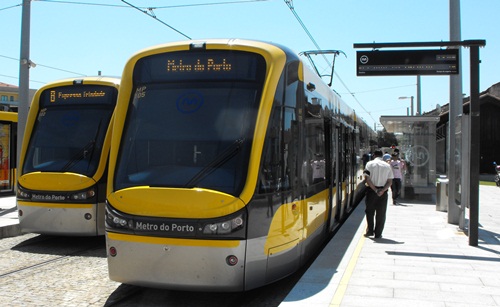
Right: Flexity Swift units at Póvoa de Varzim, 2011
Line E:
Line E (Violet) diverges at Verdes station from the other routes to the north out of Oporto and runs to the west to the city's Sá-Carneiro airport as a 1.4km branch off Line B. This extension opened on 27 May 2006 and ends in a glass canopied station alongside the mainterminal, though it is a bit of a route march betwen Metro and airport Departures, especially.
Line F:
Line F (Orange), opened in January 2011, is currently the only line that runs east beyond the Estádio do Dragão, through Contumil (a Metro station near to the CP railway station of that name) to ten new stations, terminating at Fanzeres (Gondomar). Some of the new section is on grassed reservation.
Trindade Station
Trindade Station lies short distance behind the city's town hall and is the hub of the Metro service, with all six lines passing through it. Line D uses the lower level, whilst all other Lines operate through the station from the same two platforms in the upper (street) level. There is a stub line in addition to these two through platforms, behind which stands the Loja Andante (Andante Shop), from where Metro and STCP bus passes and information can be obtained. The station also has numerous automatic ticket machines and validators. There is an excellent bar/café on the main upper level platform towards Estádio do Dragão and more refreshment facilities in the lower level, too.
When used as a narrow gauage train station Trindade had a hemmed-in feel with its six narrow platforms and intensive services. Now, with just two platforms in normal use at the upper level, it feels spacious, though all Metros still have to negotiate a tight curve to exit the station to the north through the old tunnel which survives from narrow-gauge days.
Until a few years ago, Trindade station (seen, below left, in process of demolition in 2001) was a narrow gauge CP station for services to Póvoa do Varzim, Trofa and other towns north of the city. The adjacent photos show it as demolition took place. The top photo shows the frontage which, in the lower photo, is the street facing aspect of the white building in the lower left corner, facing away from the camera to the left and bearing the CP logo. The old railway tracks ran more or less horizontally with the bottom of the photo, the buffers being sited on the left side of the image, whilst other lines curved towards where the bus is seen in the middle photo. Trindade remained a building site as late as summer 2005, even though the Metro was operational behind the hoardings. The lower part of the now two-level station provides a tunnel connection by Metro to the main line station at Campanhã, which otherwise lies an inconvenient distance east of the city centre.
Below l. to r.: Trindade CP station being demolished in 2001 (exterior); centre, the same site (interior) 2001; right, the new station - the grass to the right is the roof of Trindade Metro station
Vehicles
On 22 May 2001 the first of 72 light-rail cars for the Metro do Porto, running on 1435mm gauge, was unveiled at Massarelos depot. These 35 metre vehicles are seven-sectioned Bombardier Eurotrams, each with a capacity of 291 people (80 seated). Final assembly of these vehicles was at Amadora, near Lisbon, in what used to be the Sorefame works which are now part of the Bombardier empire. Later Eurotrams were renamed Flexity Outlooks by Bombardier.
Street-running trials of the new vehicles began in June 2002 and a trial service to Senhor de Matosinhos was opened from 2 September 2002 but the first commercial runs were not until 7 December 2002. Services were free to users till the start of 2003 and a million passengers had been carried inside the first three months. Oporto has the biggest fleet of Eurotrams in operation anywhere. They are totally low-floor and bi-directional vehicles. Similar trams also operate in Strasbourg and Milan.
In 2006 the Metro ordered Flexity Swift trams to be delivered from late 2008. These are 3-section vehicles which, unlike the Outlooks, are only 70% low-floor and are employed mainly on the longer Metro routes such as to Póvoa de Varzim and ISMAI. They have a top operating speed of 62mph (100kph).
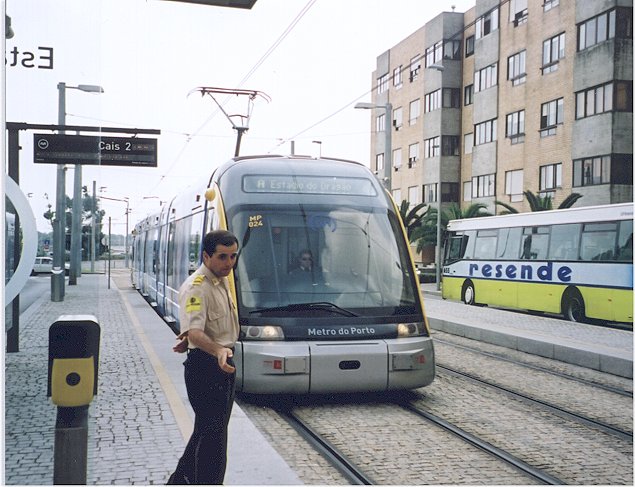
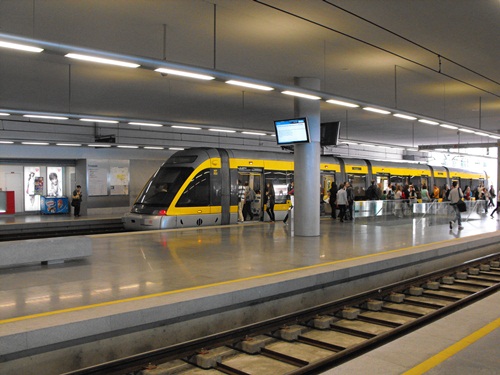
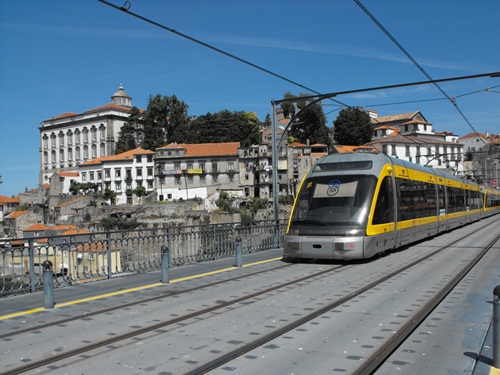
Above: Left- Blue Line service at Estádio do Mar en route to Estádio do Dragão in June 2005. Note the presence of the security man, even at the surface stations in mid-afternoon. Centre - A 2011 shot of Trindade showing a service heading for Estádio do Dragão. The platform beyond serves north and westbound services, whilst the foreground shows a stub platform not normally used. The north-south Yellow line runs at a lower level of Trindade station. Right: Metro on the Yellow Line heading across the D. Luís bridge towards Gaia, 2011.
Tickets
The electronic Andante ticket is valid both on the Metro and STCP bus services. Metro services typically run from 0600 to approx. 0130 hours.
Reading and Links
An excellent article by Manuel Tão and Carlos Fonseca on the Metro do Porto is in Today's Railways, No.120, December 2005.
Neil Pulling has written an excellent article on the Metro do Porto in Tramways & Urban Transit, no.851 (November 2008), pp. 418-422,
Copyright: ©
Contact: the following is not a link; please transcribe the address into your email 

 18 November 2011
18 November 2011



